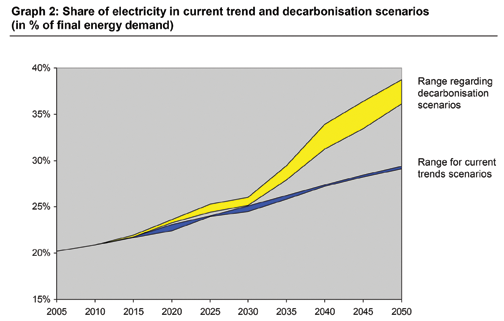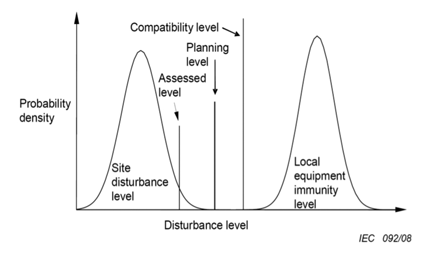With smart grid technologies as well as power technologies for renewables and improved energy efficiency, there is an increased use of electronics. We see a growth in the use of power electronics as well as electronics for information technologies. The term Smart Grid enables a Smart Electrical System – the entire power system with networks as well as connected equipment converting between electrical energy and other forms of useful energy.
Fighting Climate Change Means More Electronics
Electrification clearly facilitates our progress toward a resource-efficient and climate-friendly energy system. The share of electricity in total energy demand is projected to increase drastically in all the decarbonasation scenarios of the recent European Union (EU) Energy Road Map 20501 (Figure 1).

Figure 1: Share of electricity in final energy demand, according to the EU Energy Road Map 2050
Wind and solar power are examples of expanding technologies for renewable power. Germany now has 25 gigawatts of installed solar power2. Electric vehicles, light emitting diode lamps and heat pumps are energy efficient electrical technologies of importance when fighting climate change. In virtually all such technologies, electrical energy is passing power electronics. In addition to power electronics, there is also an increased use of electronics for supervision and control.
Smart Grid is More than Networks
The smart grid is a very topical issue. The term is widely used by many, especially politicians. Now the International Electrotechnical Commission (IEC) has defined the concept of smart grid3. The definition states that the smart grid is an electrical energy system that uses information technology. The smart grid is thus not only related to electrical networks, but to entire the power system. With smart grid technologies as well as power technologies for renewables and improved energy efficiency, there is an increased use of electronics. We see growth in the use of power electronics, as well as electronics for information technologies.
One example of smart grid application is the possibility of charging electric car batteries during hours with a surplus of low cost renewable energy. When electricity price is high, electric cars may feed energy back to the electrical network. This can be achieved using a continuous transfer of electricity price information with automatic control of the power flow to and from the electric cars. The term smart grid is thus enabling a ”smart” electrical system where the entire power system, with networks as well as connected equipment, is converting between electrical energy and other forms of useful energy.
Smart Grid and the Concept of EMC
The physical characteristic of smart grid technologies, with an increased incorporation of potentially sensitive electronics, naturally has implications with respect to electromagnetic compatibility (EMC). The satisfactory function of electrical and electronic equipment with respect to electromagnetic disturbances is the aim of EMC. The IEC defines4 electromagnetic compatibility as ”the ability of an equipment or system to function satisfactorily in its electromagnetic environment without introducing intolerable electromagnetic disturbances to anything in that environment”. In the European Union EMC Directive the ”equipment or system” of IEC corresponds to the EU term “equipment”, where equipment in turn is subdivided into apparatus and fixed installation.
Electromagnetic disturbances may be radiated or conducted and electrical/electronic equipment is potentially sensitive to any or to both of these types of disturbances. Disturbances are in turn subdivided into a number of low and high frequency phenomena, where IEC defines low frequency up to and including 9 kilohertz.
Field Experiences with Smart Grid Technology
Examples of lack of EMC in relation to evolving smart grid technologies have been reported in Sweden. Kilowatt-hour meters in households sending data signals through power lines have caused interference with, for example, dimmer controlled lamps and electrical appliances. There are also cases reported where electrical apparatuses in households have interfered with electronic kilowatt-hour meters with adverse errors in registration of energy. Power electronics in wind power plants have emitted disturbances interfering with transfer of kilowatt-hour meter readings as signals on power lines.
Power electronic-based photovoltaic solar and wind energy equipment may emit disturbances causing variations such as voltage fluctuations and unbalance5. However, with a proper design such equipment may well improve voltage quality, for instance by reducing depth of voltage dips6.
Voltage Quality and EMC
Both IEC and EU define EMC to cover electromagnetic phenomena from zero hertz. Furthermore, the IEC defines the following principal electromagnetic conducted phenomena7:
Conducted low-frequency phenomena:
- harmonics, interharmonics
- signals superimposed on power lines
- voltage fluctuations
- voltage dips and interruptions
- voltage unbalance
- power frequency variations
- induced low-frequency voltages
- DC component in AC networks
Conducted high-frequency phenomena:
- induced voltages or currents
- unidirectional transients
- oscillatory transients
Voltage quality can be seen as an umbrella name for deviations from ideal voltage conditions at a site in a network8. This is equivalent to electromagnetic disturbances of the voltage at the site. With no disturbances the voltage quality is perfect, otherwise it is not. electromagnetic disturbances are defined as electromagnetic phenomena that may degrade the performance of equipment9. Adequate voltage quality contributes to the satisfactory function of electrical and electronic equipment in terms of electromagnetic compatibility. Electromagnetic disturbances as imperfect voltage quality at a site in a network can be regarded as electromagnetic emission from the network10. According to the EMC Directive, a network is equipment. This is in line with the original name of the IEC Technical Committee (TC) 77, which was EMC Between Electrical Equipment Including Networks and is now simply EMC11.
The technical function of an electrical network is electromagnetic energy transfer with adequate voltage quality at its sites(connection points). Similarly, immunity of an electrical network can be seen as the ability to absorb disturbing emissions (such as distorted current) with adequate voltage quality while transferring energy or, in other words, with satisfactory function. For example, for low order harmonics and voltage fluctuations, network strength is relevant for network immunity12, 13.
Geomagnetically-induced current caused by space weather is another example of the relevance of electromagnetic immunity for keeping an electric grid14 functioning satisfactorily.
The importance of voltage quality to achieve EMC is clearly stated in a report from the Council of European Energy Regulators (CEER)15: “Due to the nature of electricity, voltage quality is affected by all the parties connected to the power system. When voltage quality is too poor, a key question is whether the disturbance (e.g. a harmonic disturbance) from a customer’s installation into the power system is too big or whether the power system (the short circuit power) at the point of connection is too weak. The aim should be to have an electromagnetic environment where electrical equipment and systems function satisfactorily without introducing intolerable electromagnetic disturbances to other equipment. This situation is referred to as electromagnetic compatibility (EMC).”
Equipment-based Power System Model
Power systems consist of electrical equipment. Beyond safety, the usefulness of electricity in power systems relies on the function of such equipment. Electromagnetic compatibility is about the satisfactory function of equipment with respect to electromagnetic disturbances.
According to the EMC Directive, equipment are either apparatus or a fixed installation. Apparatuses are part of the EU system for CE marking, while fixed installations are not. However, protection requirements on emission and immunity are enforced on all equipment.
Examples of fixed installations are16: power plants, power supply networks, wind turbine stations, industrial plants and railway infrastructures. According to the EMC Guide, the classification of fixed installations is wide and the ”definition covers all installations from the smallest residential electrical installation through to national electrical and telephone networks, including all commercial and industrial installations”.
Applying the concept of fixed installations to power systems may suggest a schematic illustration like Figure 2. As indicated in the picture, various types of equipment are connected to other types of equipment. Equipment for energy conversion is normally connected to only one other type of equipment, creating a network. Equipment for conveying energy, such as networks, are normally connected to several other types of equipment including networks.

Figure 2: Power system made-up of equipment
Compatibility Margins and Protection Requirements
The objective of protection requirements for equipment, including fixed installations such as electrical networks and connected equipment, is the achievement of EMC.
When aiming for EMC in electrical power systems, it is reasonable to apply the same reference for voltage quality (emission) in electrical networks as for limits on immunity of connected equipment. This is schematically indicated in Figure 3, where a common compatibility level is applied for voltage quality as well as for immunity of connected equipment. Electromagnetic compatibility levels are defined in the IEC 61000-2 series (IEC 61000-2/4/12 for use as references for emission and immunity of equipment). For very slow voltage variations, limits are given in the standard IEC 60038. Network emission levels, which are essentially voltage quality planning levels, are defined with a margin in relation to compatibility levels, as indicated in Figure 3.

Figure 3: Voltage Quality concepts with time statistics for a site within a network17
Protection Requirements for Equipment in Power Systems
In the following example, application of protection requirements on emission and immunity are illustrated for selected principal electromagnetic phenomena.
Harmonics and Interharmonics
Origins of low order harmonics are, for example, classical line commutated diode and/or thyristors based rectifiers. Examples of equipment emitting high order harmonics are voltage source converters, such as transistors which are switched at high frequency.
Emission of low order harmonics can often be modeled as current sources, while high order harmonics normally appear as voltage sources. In between these two simplified models there is naturally a more complex reality. Resonances may increase the complexity further.
When harmonic current of low order is injected into a network, the voltage is distorted which reduces voltage quality. The level of voltage distortion is dependent on the network strength. Similarly, high frequency current harmonics may cause voltage harmonics in the network. Network strength in terms of short-circuit power or fundamental frequency short-circuit impedance is less essential for voltage quality at higher frequencies. The geographical spread of higher frequency distortion is normally relatively small.
Current harmonics may cause overheating of e.g. neutral conductors and capacitors in three-phase systems. Voltage harmonics may upset electronics, e.g. due to multiple zero crossings. Loading capability of induction machines may be reduced.
Some sources of interharmonics are frequency converters and transformers saturated during energizing.
Suggested responsibilities for equipment’s accountable parties are given in Table 1. Compatibility margins are found in IEC 61000-2/4/12. A basis for apportionment of harmonic disturbances in networks is available in IEC 61000-3-6.
| Responsible | Emission | Immunity |
| Network operator | Voltage quality planning levels | Apportioning of distortion limits (except at public low voltage), network strength at lower frequencies |
| Equipment connected to network (may be another network) | Fulfillment of emission standards (e.g. within CE marking system), as well as as well as fulfillment of network operator apportioning levels | Fulfilling of immunity standards (e.g. within CE marking system), as well as consideration for EMC in own equipment |
Table 1: Responsibility for protection requirements – harmonics and interharmonics
Voltage Fluctuations
Voltage fluctuations may range from very slow voltage variations to rapid voltage fluctuations. Very slow voltage variations are equivalent to variations within voltage ranges, i.e. voltage deviations from nominal values. If the nominal voltage is 230 volt and the actual voltage is 240 volt, there is a voltage variation of 10 volts, which is an electromagnetic disturbance. However, a very slow variation causing an offset of only 10 volts is, in practice, not expected to cause any interference. Limits for very slow voltage variations are given in IEC 60038 at supply terminals, i.e. the connection point between the network and connected equipment.
Suggested responsibilities for controlling voltage fluctuations within the network system are given in Table 2. Slow voltage variations in a network are depending on a number of technical issues ranging from design, maintenance and operation.
Rapid voltage fluctuations may cause flickering of lights. Source of disturbance may be electric arc furnaces that cause rapid current fluctuations.
Suggested responsibilities for equipment’s accountable parties are given in Table 2. A framework for apportioning of distortion limits is given in IEC 61000-3-7.
| Responsible | Emission | Immunity |
| Network operator | Voltage quality planning levels | Network strength, apportioning of distortion limits (except at public low voltage) |
| Equipment connected to network (may be another network) | Fast changes in active and reactive power demand, generation kept within limits stated by network operator | Fulfilling of immunity standards (e.g. within CE-marking system), as well as consideration for EMC in own equipment |
Table 2: Responsible for Protection Requirements – Rapid Voltage Fluctuations
Convergence of Standards
A smart grid enables more renewables and more efficient use of electricity. The smart grid also is expected to boost use of electronically based equipment in the electrical power system.
To realize the smart grid, the following issues are important to consider:
- EMC is essential for a robust smart grid, both with respect to radiated and to conducted disturbances.
- Power quality is a means to achieve EMC between the smart grid and connected equipment.
- Electrical networks, including smart grids, are equipment.
- Protection requirements, such as those for emission and immunity, also are valid for electrical networks.
- Protection requirements for networks and connected equipment should be economically and fairly balanced.
- A complete set of standards for EMC in power systems, including power quality, is needed from the standardization community.
- Seeing EMC as a technical issue, where cost optimization is to a large extent governed by the standardisation community, regulatory frameworks should be designed without links to market mechanisms, i.e. similar to the handling of electrical safety.
Changing Focus in Low Frequency EMC Over Time
Over the years, focus has shifted between various electromagnetic phenomena. During 1980s, low-order harmonics were high on the agenda due to the introduction of thyristor and diode based current stiff line commutated power electronics. Similarly, voltage fluctuations causing flickering lights were of great concern where arc furnaces were the main source of disturbances. In the 1990s, the use of variable speed drives for induction motors was introduced on a large scale. Voltage dips were causing interruptions in industrial processes due to inadequate immunity for those drive systems.
Presently, there is an increased awareness of electromagnetic disturbances in the frequency range 2 to 150 kilohertz. This is due to switched converter technologies used over time in an increasing number of apparatuses, from energy efficient luminaries to charging units for electrical vehicles. Due to connection of wind and solar power at the end of weak feeders, the occurrence of temporary overvoltages is a disturbance of increased concern. Regardless of the phenomena, it is clear that a appropriate division of responsibilities for networks and connected equipment is paramount.
Notes
- European Union Energy Roadmap 2050. Available: http://ec.europa.eu/energy/energy2020/roadmap/index_en.htm
- “Germany Eyes Cutting Solar Incentives Faster”, Reuters UPDATE 1. Available: http://www.reuters.com/article/2012/01/25/germany-solar-idUSL5E8CP43M20120125
- International Electrotechnical Vocabulary (IEV), IEC 600 50-121 Std. Available: http://www.electropedia.org.
- International Electrotechnical Vocabulary (IEV),IEC 600 50-121 Std. Available: http://www.electropedia.org.
- Bollen, M. H. J. Gu, I. Y. H.,and Wiley, Signal Processing of Power Quality Disturbances, IEEE Press, 2006.
- Martinez-Velasco, J.A., and Martin-Arnedo, J.“Distributed Generation Impact on VoltageSags in Distribution Networks”,9th International Conference Electric Power and Distribution, Barcelona, 9 – 11 October 2007. Available: http://www.leonardo-energy.org/webfm_send/1085.
- IEC Guide 107 Edition 3: Electromagnetic Compatibility – Guide to the Drafting of Electromagnetic Compatibility Publications, IEC, February 2009.
- Olofsson, M. and Grape, U., “Voltage Quality in the Context of EMC, Paper 21R4-4”, 2009 International Symposium on Electromagnetic Compatibility, Kyoto, Japan, 20 – 24 July 2009. Available: http://www.elsakerhetsverket.se/PageFiles/450/Voltage%20Quality%20in%20the%20context%20of%20EMC%2021R4-4.pdf.
- International Electrotechnical Vocabulary (IEV),IEC 600 50-161 Std. Available: http://www.electropedia.org.
- Olofsson, M. and Grape, U., “Framework for Electromagnetic Compatibility in Electric Power Systems”, VIII International Symposium and Exhibition on Electromagnetic Compatibilityand Electromagnetic Ecology, St. Petersburg, Russia, 16 – 19 June 2009. Available:http://www.elsakerhetsverket.se/PageFiles/450/Framework%20for%20Electromagnetic%20Compatibility%20in%20Electric%20Power%20Systems.pdf.
- Tokuda, M., “History and Recent Topics of IEC TC 77 (EMC Standards)”, Workshop at 2009 International Symposium on Electromagnetic Compatibility, Kyoto, Japan, 20 – 24 July 2009.
- Norberg, P., Larsson, A., Sundell, M., Grape, U., “Introducing Network Strength to Handle Power Quality in System Planning, Paper C4-118”, Cigré General Session, Paris, France, 2008.
- Lo Schiavo, L., Delfanti, M., Merlo, M., Pasquadieisceglie, M.S., Pozzi, M.,“Relating Power Quality and Short Circuit Power: A Detailed Analysis of Italian MV Networks, Paper 0898”, CIRED 19th International Conference on Electricity Distribution, Vienna, Italy, 21 – 24 May 2007.
- Erinmez, I.A., Majithia, S., Rogers, C., Yasuhiro, T., Ogawa, S., Swahn, H., Kappenman, J.G., Application of Modeling Techniques to Assess Geomagnetically Induced Current Risks on the NGC Transmission System, CIGRE Paper 39-304/2002-03-26”, Cigré, 2002.
- Council of European Energy Regulators, Electricity Working Group Quality of Supply Task Force, 4th Benchmarking Report on Quality of Electricity Supply, Ref: C08-EQS-24-04 6 December 2008. Available: https://selectra.co.uk/energy/guides/CEER
- Guide for the EMC Directive 2004/108/EC, 8 February 2010. Available: http://ec.europa.eu/enterprise/sectors/electrical/files/emc_guide__updated_20100208_v3_en.pdf.
- Electromagnetic Compatibility (EMC) – Part 3-6: Limits – Assessment of emission limits for the connection of distorting installations to MV, HV and EHV power systems, IEC/TR 61000-3-6, Ed. 2.0, Febuary 2008.
 |
Dr. Magnus Olofsson is an IEEE Senior Member and chairman of the Technical Committee TC 7 (Low Frequency EMC) of the IEEE EMC Society. He is president of Elforsk, which is the Swedish Electrical Utilities’ R & D Company. |
